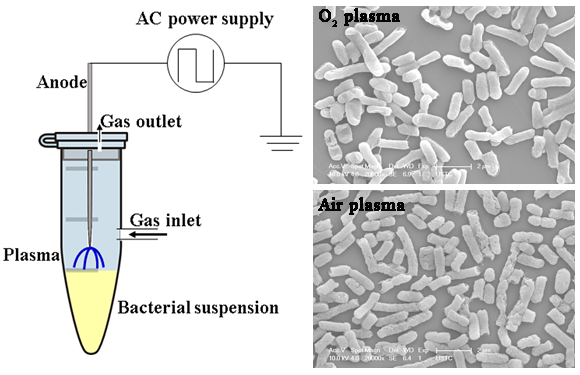Recently, a study team led by Prof. HUANG Qing in Institute of Technical Biology & Agriculture Engineering, Hefei Institutes of Physical Science, joined hands with Prof. Greg Fridman and Alexander Fridman in Drexel University and Prof. YU Liangdeng in Chiang Mai University to explore the impact of gas composition on the bactericidal efficiency by discharge plasma.
Thanks to its great application potentials and unique advantages, low-temperature discharge plasma emerges as an innovative and attractive technology in bio-medicine field, especially in sterilization. Until now, numerous groups have reported promising results regarding the use of discharge plasma in bacterial inactivation in wastewater treatment, medical sterilization, agricultural production, food safety management and so on.
Several active agents are produced by the plasma, such as electrons, ions, neutrals, reactive oxygen/nitrogen species (ROS/RNS), and electromagnetic radiation. All these active agents participate in the bactericidal inactivation process, and every experimental parameter which influences the generation or action of these active agents on microbes can affect the bactericidal efficiency.
Since the discharge gas type affects the generation of active agents by plasma, and therefore, it is expected to have significant effect on the bactericidal efficiency. However, up to now, a unified conclusion for the impact of gas composition on the bactericidal efficiency has not been reached.
To reach the goal, Prof. HUANG’s team found that the gas types and their combination (O2, N2 and air) have great impact on the inactivation efficiency of Escherichia coli by discharge plasma at the gas-solution interface.
Among the three gas types investigated, the air plasma had the strongest sterilization capability, followed by N2 plasma, while O2 plasma had the lowest.
The reason for the gas type and composition to influence the sterilization capability was mainly due to that they influenced the nitrite production in solution which further reacted with plasma-produced H2O2 in acidified medium to form a strong oxidant peroxynitrite.
The produced peroxynitrite could damage both the membrane and DNA, especially the former, and consequently inactivate thebacteria lethally.
The results of this research have been published in Clinical Plasma Medicine (7-8: 1-8, 2017) entitled Effect of N2/O2composition on inactivation efficiency of Escherichia coli by discharge plasma at the gas-solution interface.
This work was supported by the National Nature Science Foundation of China, the Natural Science Foundation of Anhui Province, and also the Youth Innovation Promotion Association of the Chinese Academy of Sciences.

Left: Schematic diagram of discharge plasma device. Right: SEM observations of E. coli after air and O2 plasma treatment. (Imaged by KE Zhigang)
Contact:
Prof. HUANG Qing
Institute of Technical Biology & Agriculture Engineering
Hefei 230031, Anhui, China
Tel: 86-551-65595261
Email: huangq@ipp.ac.cn
 Tel: +86-551-65591206
Tel: +86-551-65591206
 Fax: +86-551-65591270
Fax: +86-551-65591270
 Emai: zhous@hfcas.ac.cn
Emai: zhous@hfcas.ac.cn
 350 Shushanhu Road
350 Shushanhu Road